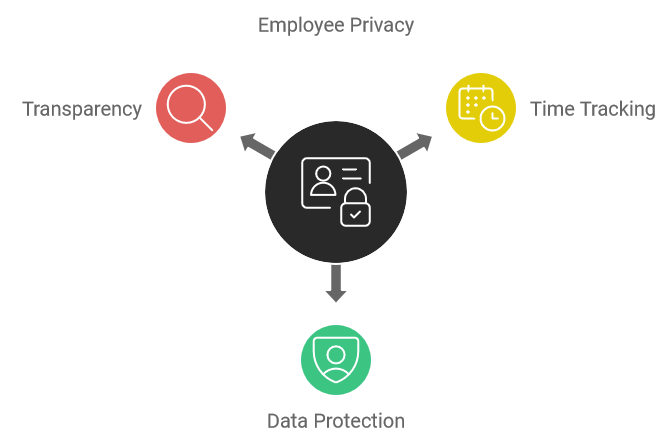Time Tracking for Labor Laws Compliance: Essential Insights for Services Businesses
In this article, you will learn about time tracking for labor laws compliance: Essential insights for services businesses
6 min read
Time tracking for labor laws compliance is crucial for maintaining legal standards and ensuring fair treatment of employees.
Many service businesses, like agencies, BPOs, IT services companies, and professional services firms, face daily challenges when it comes to staying compliant with labor laws. Proper time tracking can simplify these complexities, provide transparency, and protect your business from legal ramifications.
In this detailed guide, we’ll explore the importance of accurate time tracking, features of an effective system, and tips to keep your business compliant with labor laws.
Importance of Accurate Time Tracking for Labor Laws Compliance
Accurate time tracking isn’t just about keeping tabs on when your employees clock in and out. It’s an essential component of labor laws compliance and operational efficiency.
- Legal Protection: Adhering to labor laws protects your business from potential lawsuits and fines. The Fair Labor Standards Act (FLSA) mandates employers to maintain accurate records of hours worked, including overtime. Failure to comply can lead to legal actions from employees or government agencies. According to the U.S. Department of Labor, back wages resulting from such disputes amounted to $322 million in 2020 alone.
- Employee Satisfaction: When employees know their hours are being tracked accurately, they are likelier to trust the company. This transparency fosters a positive work environment and can reduce turnover rates.
- Operational Efficiency: Proper time tracking helps businesses analyze productivity levels, allocate resources effectively, and reduce labor costs by identifying inefficiencies.
Pro Tip
Regularly audit your time-tracking records to catch discrepancies early and ensure continued compliance.
Features of an Effective Time-Tracking System
An effective time-tracking system should offer features that support compliance and enhance operational efficiency.
- Automated Recording: Automated systems ensure that all hours worked are accurately recorded, reducing the risk of human error. Look for features like digital punch clocks or software that captures work hours through computer activity.
- Easy Access for Employees: Employees should easily view and verify their hours. A system that provides a user-friendly portal for employees to track their time helps maintain transparency.
- Integration with Payroll: A seamless integration with your payroll system ensures that employees are paid accurately and on time.
- Compliance Features: Look for systems that track overtime, mandatory breaks, and maximum work hours, ensuring you remain compliant with labor laws.
Pro Tip
Choose a system that offers mobile access, allowing employees to track their time even when they’re not at the office.
Challenges in Time Tracking for Labor Laws Compliance
Even with the best systems in place, businesses still encounter challenges in time tracking for labor laws compliance.
- Addressing Remote Work Issues: With the increase in remote work, tracking hours becomes more complex. Employees might work outside traditional hours, making it crucial to have a remote work solution that can adapt to various working schedules.
- Ensuring Accuracy: Accuracy in recording hours is vital. Mistakes can lead to overpayments or underpayments, both of which can cause legal and financial problems.
- Handling Various Jurisdictional Laws: For businesses working across different states or countries, staying updated with local labor laws can be challenging but necessary. Each region might have different requirements for breaks, overtime, and record-keeping. Here is a resource that lists important time tracking regulations for different countries.
- Resistance from Employees: Employees might feel that time tracking is a way of micromanaging their work. It’s essential to communicate the reasons and benefits of accurate time tracking to gain their support.
Pro Tip
Conduct training sessions to educate employees on the importance of time tracking and how it protects their rights and benefits
Best Practices for Time Tracking for Labor Laws Compliance
Implementing best practices for time tracking can ensure your business stays compliant with labor laws while streamlining operations.
- Set Clear Policies: Develop and communicate clear time-tracking policies. Inform your employees about their roles and responsibilities in recording their work hours.
- Regular Audits: Periodically review your time-tracking data to ensure accuracy and compliance. Audits can help identify discrepancies and areas that need improvement.
- Use Technology: Invest in reliable employee time tracking software. Modern solutions offer various features such as biometric verification, GPS tracking, and real-time data analysis, making compliance easier.
- Ensure Data Security: Time-tracking systems handle sensitive employee information. Ensure your system complies with data protection regulations and has robust security measures.
Pro Tip
Integrate your time-tracking system with other HR tools for a comprehensive overview of employee data, making compliance monitoring easier.
Choosing the Right Time-Tracking System
With so many options available, choosing the right time-tracking system can seem overwhelming. Focus on these critical aspects to make an informed decision.
- Analyze Your Needs: Identify the specific requirements of your business. Do you need a system that handles remote work efficiently? Does your business require advanced compliance features?
- Compare Features: Look for features that align with your requirements. This could include ease of use, integration capabilities, mobile access, and comprehensive reporting.
- Consider Scalability: Choose a system that can grow with your business. As your team expands or your business requirements change, your time-tracking system should be able to scale accordingly.
- Check for Support: Reliable customer support is crucial. Ensure the provider offers timely help and resources, especially during the initial setup phase.
Pro Tip
Refer to case studies or user reviews to understand how specific time-tracking systems have helped similar businesses.
Benefits of Compliance with Labor Laws Through Effective Time Tracking
Maintaining compliance with labor laws using effective time tracking has numerous benefits for your business.
- Reduced Legal Risks: Accurate time-tracking records serve as legal protection, helping you avoid lawsuits and fines.
- Improved Employee Trust: When employees see that their time is tracked, and wages are paid correctly, it fosters a sense of trust and reliability in the company.
- Enhanced Productivity: With precise time records, you can identify areas of inefficiency and implement strategies to boost productivity.
- Better Resource Management: Time tracking can help you allocate resources more effectively, ensuring projects are completed on time and within budget.
Pro Tip
Use time tracking data to create performance benchmarks, allowing you to set realistic goals and track progress over time.
Maintaining Employee Privacy While Tracking Time

While tracking time is essential for compliance, it’s equally important to respect employee privacy.
- Limit Data Collection: Collect only the necessary data for compliance and operational purposes. Avoid intrusive monitoring that infringes on employees’ privacy.
- Communicate Purpose: Clearly communicate the purpose of time tracking to employees. Emphasize how it benefits them by ensuring accurate pay and protecting their rights.
- Ensure Transparency: Make the tracking process as transparent as possible. Allow employees to access their records and verify their hours.
- Adhere to Data Protection Laws: Ensure your time tracking system complies with data protection regulations like GDPR or CCPA, safeguarding employee information.
Pro Tip
Conduct regular privacy training sessions for your staff to keep them informed about how their data is used and protected.
Conclusion
Time tracking for labor laws compliance is not an option but a necessity for service businesses aiming to stay compliant and operate efficiently.
By investing in a reliable time-tracking system and adhering to best practices, you safeguard your business from legal risks, improve employee satisfaction, and boost overall productivity.
As labor laws continue to evolve, having a robust and flexible system in place will ensure your business stays ahead of the curve.
Pro Tip
Don't wait for a compliance issue to arise; invest in a comprehensive time-tracking system today to secure your business's future.
